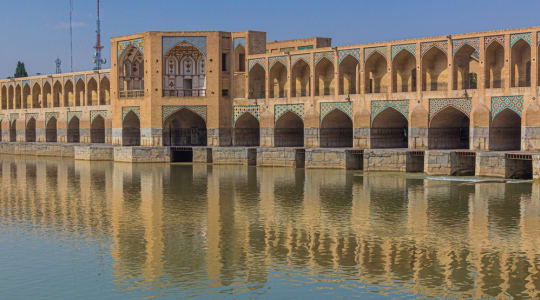Khaju Bridge is a historic bridge located in the city of Isfahan, Iran. It was built by the Persian Safavid king, Shah Abbas II, in the 17th century. The bridge spans the Zayandeh River and connects the north and south sides of Isfahan.
Khaju Bridge is a unique combination of bridge, dam, and building, and is considered one of the most beautiful bridges in Iran. It is approximately 133 meters long and 12 meters wide, and consists of two levels. The upper level was used by the royal family and their guests, while the lower level was used by the common people.
One of the most interesting features of Khaju Bridge is its 23 arches, which are all of different sizes and shapes. The arches were built to ensure the flow of water in the river, as the bridge also serves as a dam. There are also two octagonal pavilions located at the center of the bridge that were used as rest stops.
The bridge also has intricate tilework and inscriptions on its sides, which are both decorative and functional. The inscriptions include poems by the famous Persian poets Hafez and Ferdowsi.
Khaju Bridge is not only a masterpiece of engineering and architecture but also a cultural symbol of Isfahan. It has been recognized as a UNESCO World Heritage Site, and is a popular tourist attraction in Iran.
Explore Near Khaju bridge
Discover 3 attractions, 5 cities, and 1 airport within 75km. Perfect for planning day trips, finding connecting flights, or discovering new destinations to explore during your visit.
Nearby Attractions & Places to Visit
3 destinations within 2.4km - 3.7km from your location



Nearby Cities Worth Exploring
5 destinations within 1.9km - 29.8km from your location
Airports Near Khaju bridge
1 destination within 20.9km from your location
Cross-Border Adventures Near Khaju bridge
Discover cross-border adventures near Khaju bridge. Explore neighboring countries with similar attractions and extend your travel experience across borders.







